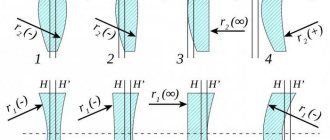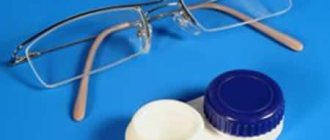Contact optics is an invention that helps correct vision and the natural shade of the eyes. Comfort is guaranteed by the correct size. But those who use contact optics, in some cases, complain of a burning sensation, dry eyes, and cephalalgia. Lenses can cause headaches when they are not fitted correctly or there is a reaction to polymers.
It is better to refuse contact optics and seek advice from an ophthalmologist. Pain only bothers those who wear incorrectly selected lenses. It is important to identify the factors causing discomfort in a timely manner.
Headache from lenses
When contact optics are adjacent to the cornea or do not match in dioptres, the head will definitely bother you. Migraine is not the only consequence; the cornea, eye membranes, and eyelids suffer. The infection develops when contact correction devices are used correctly and storage rules are violated.
Cephalgia occurs from incorrect contact optics. The head hurts after contact lenses if they release harmful components. Unstable dyes and toxic polymers cause allergies and infectious diseases. When you have a headache or purulent discharge from your eyes in the morning, you need treatment.
Dizzy in the lenses
There are also situations when, on the contrary, you feel dizzy without glasses. For example, a person decided to switch to using contact lenses. It happens that during such a transition, health worsens. Reasons may include:
- incorrectly selected size, because of this the person greatly strains his vision and becomes dizzy;
- high intraocular pressure;
- corneal diseases.
In any case, you will need to consult an ophthalmologist. Before going to the hospital, contact lenses must be removed from your eyes.
Why do lenses give me headaches?
Incorrectly selected contact correction means cause migraine attacks, sometimes the head is painfully tense in the parietal region. Unpleasant symptoms are not always associated with the eyes. The reason why lenses cause headaches is due to improper care of the optics. Infection factors:
- putting on and taking off with dirty hands,
- insufficient sanitation of the storage container;
- rare change of disinfectant solution;
- wearing for many hours (natural dust, development of pathogenic microflora).
Interesting: What pill to take for a hangover for a headache?
Another cause of pain associated with the eye is blepharospasm. Constant tension and frequent blinking cause a dull pain in the occipital and frontal parts of the head. There are other factors that can cause cephalgic syndrome.
Incorrect selection of diopters
If your head bothers you from time to time, it is better to clarify the dioptric parameters. It happens that the right and left eyes need different corrections. When wearing the same diopters, unproductive loads arise, which spasm the blood vessels of the head.
When worn for a long time, your head may hurt from too incorrect optics. Vascular spasms occur, blood flow is disrupted, and brain tissue experiences oxygen starvation. When age-related farsightedness develops, regular vision correction is necessary for people suffering from myopia. The head becomes heavy from too powerful or too weak vision correction products. Vision deteriorates from constant stress and poor nutrition.
Allergy or infection
Nasal swelling is mistaken for eye pain. An allergic or infectious runny nose provokes increased lacrimation. When the frontal part of the head hurts, it is associated with the influence of optics. Taking antihistamines and treating the infection leads to the elimination of unpleasant symptoms.
Allergies can be caused by the material used to make contact optical devices. If the pain in the frontal part of the head does not go away after a week, you should abandon contact optics. Polymers can cause dermatitis and corneal ulcers.
Dry eye syndrome
Factors causing painful syndrome:
- prolonged exposure to a monitor screen;
- low air humidity (this is typical in winter);
- consequences of surgical interventions;
- long flights;
- pathology of the lacrimal canaliculus (natural wetting does not occur);
- harmful working conditions (dust, smoke).
Interesting: What pills to take if you have a headache after drinking alcohol?
When head spasms bother you, accompanying symptoms arise: discomfort in bright light, a feeling of a foreign body in the eye.
The polymer material from which contact optics is made absorbs moisture from the cornea, which causes it to dry out. The syndrome, which causes pain in the frontal part of the head, can be eliminated with special eye drops.
Painkillers are not the answer. Complications are possible in the form of dry keratitis, when the structure of the cornea is disrupted. As a preventive measure, the diet should be adjusted; dry eye syndrome often occurs due to a lack of vitamin A.
Incorrect selection of lens type
When your head bothers you, pay attention to the symptoms that indicate the wrong choice of lenses:
- blurred image, clouding;
- fast fatiguability;
- pain in the eyes after hours of straining;
- facial muscles are constantly tense;
- increased tearfulness;
- loose fit.
The contact correction device must fit snugly to the membrane of the cornea; this is necessary for comfort. Correct selection of lens type involves determining:
- radius of base curvature (degree of curvature of the cornea);
- hemisphere diameter.
Keratometry is carried out using special equipment; the right and left eyes have different curvatures (BC). It is necessary to select lenses taking into account the parameters specified in the prescription. In humans, BC parameters vary in the range of 8.3–8.5 mm. Contact correction products are produced in the range of 7.5–9.5 mm. If the discrepancy between BC values is 0.3 mm, lenses should be individually made to prevent headaches.
Causes of dizziness from glasses
There may be several factors that cause dizziness when wearing glasses. It is worth paying attention to the synchronicity of wearing the accessory and dizziness. For example, if a person wears glasses without taking them off, perhaps his head is dizzy for another reason altogether. And if he puts them on before watching TV, and his head is dizzy during this period, he feels unwell, most likely, because of the glasses. Let's look at the most common causes of dizziness.
Unusual novelty
When the question of purchasing glasses first arises, the fact that you feel dizzy is an absolute norm. After putting on the accessory, a person may feel unpleasant symptoms as a result of:
- incorrectly selected lens size;
- hard, compressive frame;
- anti-glare coating applied to the lenses;
- uncomfortable earhook.
If all of the above conditions are normal, the dizziness will go away on its own in a maximum of a couple of weeks. If you feel dizzy when wearing the accessory after the specified period, you should consult a doctor.
Center distance
When choosing glasses, one of the leading factors is the gap between the pupils. The wrong width of the nose pad puts more strain on the eyes. That's why my head is spinning. Knowledgeable specialists spare no time in selecting an accessory for the patient. He may be offered several options for glasses so that he can feel which one is more comfortable.
Anti-reflective coating isn't just for drivers
It was previously noted that anti-glare glasses can cause discomfort. In the past, only drivers used them. But now such accessories have become more widespread. It is clear that the unusual brightness and clarity of the image leads to dizziness from the glasses. Over time, the discomfort goes away.
Thick minus lenses
The problem is that with severe myopia there is no escape from glasses with wide lenses. They put a huge strain on the eyes and also lead to distortion of the visible image. When wearing such heavy accessories, the head becomes dizzy very often, in addition, additional painful symptoms arise in the form of vomiting.
Sun protection
Glasses that are too dark, designed to protect the eyes from UV rays, lead to the exact opposite result. Due to the lack of light, the pupils are constantly dilated, which leads to fatigue, loss of strength, and dizziness. However, this does not mean that they should be completely abandoned. Doctors recommend choosing slightly darkened models.
How to help with headaches from wearing lenses?
If you have an individual intolerance to new lenses or allergic reactions to the material, it is better to avoid them. An ophthalmologist will help you choose the right diopter. The eye muscles will not strain excessively, and the headache will disappear.
Interesting: Why do you get a headache when you quit smoking?
It is important to identify the cause of cephalgia. If your head bothers you because the lenses are made of technical polymers, serious complications are possible:
- blepharitis - inflammation of the mucous membrane lining the eyelids;
- traumatic keratitis – clouding of the cornea due to the development of the inflammatory process;
- ulcerative inflammation of the cornea.
In this case, it is better to wear glasses again before quality lenses become available. It is dangerous to endure pain and relieve it with constant medication. As an emergency measure to prevent headaches from bothering you too much, let’s take non-steroidal anti-inflammatory drugs. Aspirin, Ibufen, Ketanol, Meloxicam, Paracetamol are taken no longer than three days.
Prevention
To prevent headaches when wearing an accessory, effective preventive measures will help:
- You should wear glasses only when it is really necessary, and not all day long.
- Take walks every day.
- Take breaks while working at the computer.
- Don't get carried away with watching TV.
- Eliminate psycho-emotional stress and nervous shock.
- Give yourself a rest and a good night's sleep.
- Do not drink cocktails containing alcohol.
- Do special visual exercises.
Charger
Let us dwell in more detail on gymnastics, which will relieve the condition. when you feel dizzy. Let's look at the best exercises:
- It is necessary to move only with the eyeballs, without the participation of the head, in turn up and down, left and right.
- You will need to lean your head forward and rest your hand on your forehead, as if resisting yourself.
- For the next exercise you need to select an object in the distance. First you need to close your eyes, then open your eyes and focus on the selected object. Repeat at least ten times.
When you feel dizzy while wearing glasses, it can happen for completely harmless reasons. On the other hand, such manifestations may signal the development of a pathological process in the internal environment. Therefore, at the first dizziness, you must urgently contact a medical facility for help.
Causes of headaches when wearing glasses for vision correction
Contact lenses have become affordable today, and operations to restore vision are safe and effective. Unfortunately, in some cases such approaches are prohibited.
Some people just prefer wearing glasses. Many even made them part of their image. You just need to remember the nuances of using products that have become so widespread.
Most often, the causes of headaches when wearing glasses are the result of violation of the rules for selecting or wearing an accessory by the person himself. Sometimes negative consequences result from a medical error or manufacturing defect. It is important to remember that if you get a headache from wearing glasses, you cannot tolerate this condition! Trying to eliminate cephalalgia with pills will not be beneficial. The clinical picture will only worsen and be supplemented with new symptoms.
The distance between the centers of the pupils is incorrectly determined
In the process of selecting glasses, the ophthalmologist must not only determine the clarity of the patient’s vision, but also collect a lot of additional information. Ignoring these settings may result in reduced image clarity and discomfort. One of the most important is the distance between the centers of the pupils. Measuring data from only one eye and using it in the other is a serious mistake. The human face is asymmetrical, so it would be correct to collect both indicators and then indicate them in the recipe.
Allowing such inaccuracy in 90% of cases leads to the creation of unsuitable glasses. The picture is distorted; to correct it, one of the eyes begins to strain very hard to put the image in order. The muscles of the eyeball have an increased load, which is why they contract pathologically. The result is the appearance of painful sensations in the head. If everything is not corrected in time, strabismus may develop.
The optical power of the lenses is incorrectly selected
Refusal to visit an ophthalmologist to select glasses leads to headaches. People who
They contact accessory sales points directly and, in most cases, purchase products with unsuitable lenses. They are based on sensations, not exact indicators. Often the strength of the glasses is insufficient, which forces the eyes to strain. After just a few hours, such purchases can begin to cause discomfort. We also must not forget that glasses are an individual accessory, when choosing which it is necessary to take into account a number of technical parameters, and not just convenience.
It’s even worse if the optical power of the lenses for one of the eyes is incorrectly selected. In this case, the load will not even be distributed. One eyeball will be constantly in a tense state, so the headache will be persistent, severe and irritating. It may not respond to medications and physical therapy. The sensations will subside only after a long rest.
Frame is too small
Sometimes the cause of pain lies in poorly chosen frames. Cephalgia can be provoked
too tight arches blocking blood flow in the temporal arteries. Blood will stop flowing to the brain in the required volume, which will provoke oxygen starvation of the substance and the appearance of discomfort. If you continue to wear the accessory, the clinical picture will be complemented by darkening of the eyes, dizziness and even loss of consciousness.
Negative consequences are also possible as a result of excessive pressure in the bridge of the nose. If, after wearing the products, marks remain on this part of the face, this indicates a poor choice of model. In this case, cephalalgia will not be severe, and additional symptoms will not begin to accompany it. But it can increase throughout the day and cause irritation, fatigue, and decreased alertness.
Narrow lenses
The minimum lens width is beautiful, but not functional enough and even dangerous. Glass is not able to cover the entire viewing area of the eyes. During the day, the organs of vision have to be repeatedly strained when objects move beyond the influence of the lenses. Systematic creation of excessive load provokes overwork of muscle fibers, which leads to headaches. Glasses with narrow lenses are only allowed to be worn by people who use accessories only occasionally, for example, when reading or working on a computer. For people who are forced to wear products constantly, such models are contraindicated.
Deterioration of vision
Headaches can also occur after wearing glasses that were chosen correctly for a long time. This occurs due to a decrease in visual acuity or changes in other indicators necessary for their prescription. The lenses cease to cope with their functions, the eyes begin to strain too much. Such cephalgia is often accompanied by dizziness, fatigue, and absent-mindedness. It is enough to check your vision again and select accessories in accordance with the new data.
Other reasons
The development of headaches may be associated with other reasons. These include:
- Increased intraocular pressure. The headache is felt from the side where the eye is affected by glaucoma.
- Chronic sinusitis. The sinuses are located next to the eye sockets. With this disease, pain spreads to the temples and eyes.
- Dry eye syndrome is accompanied by dryness in the eyes. A person begins to blink more intensely to produce tear fluid and hydration. By evening, the eye muscles become tired, causing headaches.
- Xerophthalmia is drying of the cornea and conjunctiva. The cause is vitamin deficiency, trachoma and chemical burns. Any of the pathologies is accompanied by this symptom.
- Cellulitis of the lacrimal sac is characterized by significant swelling and hyperemia of the skin. The palpebral fissure narrows or closes completely. The disease is characterized by fever, general malaise and headache as an abscess begins to form.
The cause may also be severe strabismus, an inflammatory or infectious disease.










